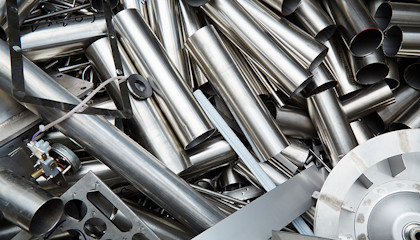Increased efficiency through production analysis

Sandvik is using artificial intelligence to improve steel production processes, reducing both its costs and environmental impact.
Launched in spring 2018, the research project Swedish Metal featured a collaboration between business area Sandvik Materials Technology, the University of Skövde and Swedish-Finnish steel company SSAB. The project team is carrying out extensive production analysis work with the help of artificial intelligence (AI), big data and machine learning. The goal is a more efficient and sustainable steel production process.
Sandvik focuses on the analysis of production data to better map the content of internally recycled material. The aim is to increase the proportion of recycled material used – and reduce the need to add virgin materials – during steel production.
“In the current situation, we cannot utilize all the groups of recycled steel to the maximum, because we have to take into account the uncertainty surrounding their composition and distribution,” says Magnus Josefsson, responsible for raw material optimization at Sandvik.
Academic collaboration
Sandvik is sending large amounts of data from the steelworks process to researchers at the University of Skövde for analysis.
“The basic idea is to study the connection between what raw materials we introduce into the molten iron and what steel composition is output, but we also use secondary data such as electricity use and oxide content in the slag. We hope that the new algorithms will be able to detect metal losses and material contaminants between different batches of molten iron and thereby isolate the effects that are due to unexpected content in the raw materials.”
We expect to be able to find better ways of utilizing the recycled material so that it is possible to reduce the proportion of alloys without risking poorer quality in the final product.
An important goal of the analysis work is to fine-tune the existing raw material optimization algorithms that Sandvik uses in its production process. It is expected that this will make it possible to optimize raw material costs without compromising on steel quality.
“The material that we currently melt consists of about 45 percent internally recycled steel and residual products and 35 percent purchased scrap,” says Josefsson. “The rest is purely metal alloys. We expect to be able to find better ways of utilizing the recycled material so that it is possible to reduce the proportion of alloys without risking poorer quality in the final product.”
Improving efficiency, improving circularity
The project is scheduled to continue for three years. Josefsson expects that an initial result will be a clear snapshot of how the raw material mix can be improved in order to increase quality and efficiency as well as sustainability.
“I hope that the analysis procedure can be implemented in a way that allows it to be conducted continuously in the future,” he says.
“Then we would be able to identify problems with the recycled steel sorting as they arise, and thus be able to put in place measures to prevent the problems.” In parallel with the efforts to reduce the proportion of alloys that are added, work is also underway to reduce the proportion of scrapping that takes place in production, which further increases the need to use the available recycled steel in the best possible way.
“Even though it is better to use recycled products than to buy alloys in order to economize on raw materials, the optimal scenario is not to circulate the material multiple times. It would, of course, be better if as much of the material as possible could be sold directly, so another important goal for us is how we can scrap less material.”
Sustainability focus equals optimizing processes
A key reason for Sandvik to become involved in the Swedish Metal project is reduced production costs, the result of using cheaper materials and reducing electricity consumption. It will also likely help the business gain detailed control of its processes and optimize them.
“Increasing competitiveness and distinguishing ourselves from our international competitors has become ever more important,” says Josefsson. “In addition, we take the subject of sustainability very seriously. By demonstrating how hard we work with this issue, I think we can increase our chances of attracting new expertise in the future.”